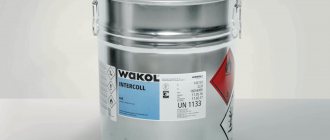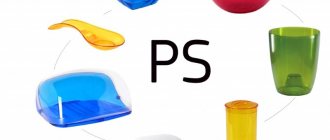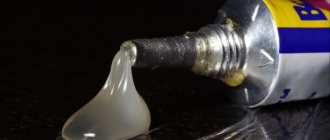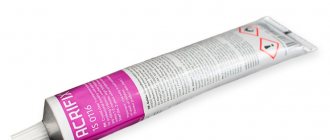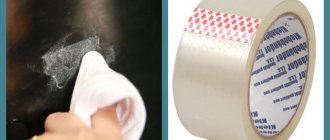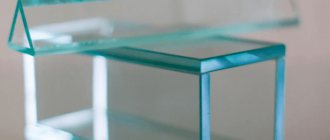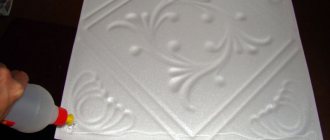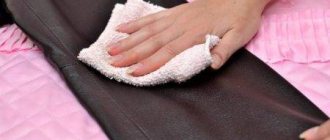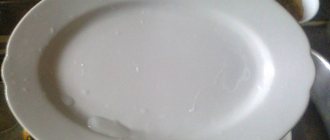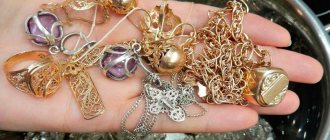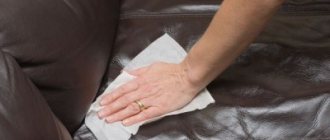Gluing plastic is a very common way of creating a permanent connection of structural parts using glue. Before answering the question: how to glue plastic, you should familiarize yourself with the features of this material.
The strength of the connection depends on several factors:
- properties of the plastic to be bonded (wettability, solubility, structure, molecular polarity, degree of modification and surface condition);
- properties of the adhesive (cohesive strength, structure and polarity of macromolecules, rheological properties, wetting ability);
- technological and design parameters.
Based on their tendency to stick together, plastics are divided into several groups:
- easy to glue, which do not require special effort and expense for surface preparation (polyacrylates, ABS plastics, unplasticized polyvinyl chloride, aminoplasts, etc.);
- conditionally easy to glue, requiring the use of special adhesives (polystyrene, plasticized PVC, polyamides, etc.);
- difficult to glue (high-impact polystyrene, polypropylene, some types of thermosets based on organosilicon resins, fluoroplastic, polyethylene). This group of plastics requires special preparation of the bonded surfaces.
Various modifiers, dyes, antistatic agents and other additives are always added to the composition of industrial polymers. All of them affect the adhesive properties of the material, so in each specific case the adhesive ability of the plastic is assessed. Only after obtaining the result can you decide which glue to use to glue the plastic of one or another modification.
What glue should I use to glue plastic?
At the moment, there is no universal adhesive that can be used to join any type of plastic. The industry produces a large number of compounds, each of which has its own set of strength, physicochemical and technological properties.
Depending on the chemical nature, adhesives for plastics are divided into two groups:
- thermosetting (made on the basis of polyester, epoxy and other thermosetting resins);
- thermoplastic.
Thermoplastic compounds, in turn, are divided into two subgroups:
- based on thermoplastic resins;
- based on thermoplastic rubbers.
Thermoplastic compounds are capable of melting, dissolving, softening under the influence of temperature and are prone to creep. Their chemical structure (unlike thermosets) does not change their chemical structure during the formation of an adhesive joint.
Liqui Moly
This German manufacturer is one of the most popular manufacturers of vehicle consumables. The glue perfectly connects rough overlapping elements. The dispenser is very convenient to use, and the composition itself dries quickly.
The instructions precisely describe what precautions must be taken when working with the substance. The disadvantage is that it is not very durable.
One-component and two-component adhesives
Based on the number of components, adhesive solutions are divided into:
- one-component;
- two-component.
One-component formulations are supplied for sale ready-to-use in a single package.
The delivery set of two-component adhesives for plastic includes two packages of their components. Before gluing the product, they must be mixed according to the manufacturer's instructions.
An example of a one-component adhesive is instant Cosmoplast 500, intended for gluing profiles in window production. It can be used in both manual and industrial production.
The long-known epoxy adhesive for plastics is a two-component one. One of its components is epoxy resin, the second is a hardener. Unlike one-component solutions, two-component solutions have a longer shelf life: after all, until their components come into contact, curing does not occur.
Hot melt adhesive
A special composition that is capable of connecting plastic elements. Supplied in rod form. The distinctive features here are as follows:
- gluing is possible only in case of strong heating;
- A special gun is required for operation.
Basically, such a product is used for creativity, since the strength of the finished items is not too high, as a result of which the repaired products will not serve for a long period.
The choice of a specific model is influenced by the dimensions of the rod, the level of transparency of the substance, viscosity, operating temperature, etc.
Adhesive for ABS plastic
Thermoplastic ternary copolymer of three components: acrylonitrile, butadiene and styrene (ABS) is best glued with a one-component polyurethane adhesive and sealant. Sometimes two-component compositions based on the same polyurethane are used for this purpose. One of these adhesives is SUPER NN, costing 299 rubles per liter bottle.
Among the new developments, TAMIYA CEMENT for ABC worth 168 rubles can be noted. For this price you can buy a small bottle of 40 ml.
Cosmofen CA 12
Another product from America, but this time the price is in the middle price range. The bottle is distinguished by its ergonomic shape and fairly large volume.
The instructions are clear, there is a translation into Russian. On the other hand, the gluing performance here is very mediocre, and even after use there is some glue left on the cap.
Adhesive for polypropylene
For gluing polypropylene, you can use two-component structural adhesive WEICON Easy-Mix PE-PP. By the way, they can also glue polyethylene. The basis of this brand of glue is methyl acrylate. The cost of 50 milliliters of this product is 50 euros.
Today you don’t have to rack your brains over the question: how to glue pp plastic without much hassle. Dubfix recently introduced its new product - transparent double-sided adhesive tape designed for repairing polypropylene products. The manufacturer claims that the use of such a tape can replace the operation of welding polymers, while ensuring high joint strength. The tape is supplied in rolls 25.4 meters long. The cost ranges from 90 to 112 rubles per piece.
ABRO Super Glue
The production is carried out by the world famous American brand ABRO. The cost is one of the lowest (you can buy it for just a couple of tens of rubles), however, that’s where the advantages end.
The quality is very low, the instructions in Russian are very unclear. It may be suitable for small elements, but it is not recommended to glue anything important with ABRO Super Glue.
How to glue PVC plastic?
Polyvinyl chloride is found quite often in everyday life. Tiles, floor coverings, etc. are made from it. This material is perfectly adhesive with one-component PROK. Another name for it is “liquid plastic”. The adhesive can be used to bond polyvinyl chloride (PVC), both solid and foam. The action of the glue is based on the diffusion welding method. Liquid plastic is used in window production, plumbing work, and also for the structural connection of rigid PVC parts.
A tube of PVC glue “liquid plastic” costs 250 rubles.
Video: “Two-component adhesive for plastic restoration”
3M Scotch-Weld
The composition is produced in England. Its advantages include a large packaging volume, ease of operation, as well as excellent adhesion performance in the case of glossy surfaces. However, if the edges are rough, the effectiveness is greatly reduced.
Another disadvantage is that the glue in the dispenser hardens very quickly. The cost here is quite high, this should also be regarded as a disadvantage.
It may also be interesting: I fill the spark plugs with gasoline on the injector: what to do?
Adhesive for HPL plastic
For gluing high pressure HPL, a two-component adhesive is used. It consists of synthetic rubber and a solvent (highly volatile). In this way, HPL can be glued even to sanded particle boards. One of the widely used brands of glue for HPL is OLMI 4745. The cost of contact adhesives for plastic is approximately 200 rubles per 50 milliliters.
Despite the fact that the technology for joining different types of plastics has been well developed in the world, and there is no shortage of necessary adhesive materials for this purpose on the market, the future probably still lies with ultrasonic soldering. This is the most progressive method, during which the connection of plastic elements occurs due to the energy released by the material under the influence of ultrasound.
Features of such substances
Plastic is a fairly durable substance, but at the same time, such a material practically cannot be glued due to low adhesion and chemical reactivity.
In addition, there are no small pores on the surface. Thus, special compounds should be used to repair such elements.
There is another way to repair plastic - welding. At the same time, such a solution is only suitable for service in special workshops; this method will not be relevant in everyday life, so all that remains is to buy glue or completely replace the item.
Panels
PVC panels have become widespread due to their sufficient strength, water resistance, resistance to temperature changes, and low cost. The fastening of such a facing coating is carried out not only with glue, but also mechanically on the sheathing. The adhesive method is used when the base is level and without any defects.
The main properties of the glue in this case are resistance to temperature changes, moisture resistance, and excellent viscosity. Most often, liquid nails, Moment-Montazh or Titanium are used to fasten panels.
Advantages of cold welding
- The glue is easy to use. Welding for plastic allows you to repair almost any item made of this material without the need for heat. The use of welding is possible at home, since you do not need welding equipment or additional knowledge.
- Suitable for joining complex, fire and explosive structures.
- After welding, a sealed, waterproof, high-strength seam is obtained.
- The amount of waste is minimal.
- Affordable price and availability of glue in many construction stores.
- It does not require electricity to operate, so it can be used even in field conditions.
- Good elasticity. The composition can connect parts subject to vibration loads, shear or rupture.
- Withstands high temperatures. Universal mixtures – up to +260 °C, specialized – up to +1000 °C.
The consistency is:
- Liquid welding. Packaged in vials, bottles or boxes.
- Plasticine. Available in the form of an adhesive stick, cylindrical rod or tube. The outer layer is a hardener, and the inner layer is epoxy. To use the product, you need to cut off a piece of the tube, knead it with your fingers until you obtain a solid, homogeneous mass and apply it to the prepared surface.
The composition of the plastic welding agent is:
- One-component. This liquid product has a consistency similar to office glue. It is used to connect small parts because it has weak adhesive ability.
- Two-component. A more reliable solution. It consists of resin and hardener, which are mixed in equal proportions before use. Once the components are connected and a reaction begins between them, the user only has a few minutes to glue the plastic together.
Where is it used?
You can repair the connector of a household appliance, repair individual elements, eliminate defects and chips.
These properties are used for cosmetic and full repair of such products:
- plastic heating pipes;
- fishing rods, travel equipment;
- plastic insulation on electrical wiring;
- housings and accessories of household devices;
- car bumpers, plastic interior elements;
- garden, household or household utensils.
How to repair minor damage to a plastic car bumper
Bumper damage comes in many different types, from minor scratches and small dents to serious cracks. Small dents and scratches can be removed yourself.
If the car bumper is made of thermoactive plastic, then minor damage to it can be easily eliminated using the polishing method with special chemicals. means.
Related article: We remove chips and scratches on the car body with our own hands
For example, if there is a shallow scratch, it can be treated with WD-40 universal cleaner.
In order to polish a scratch or chip, you will need a sponge, a soft rag and a chemical reagent. First, you need to clean the damaged area from dirt and dust with a sponge and water. After applying chemical. spray or sponge. Next, the damaged area is intensively polished with a rag until no damage is visible on it.
The second way to eliminate small dents and scratches on a plastic car bumper is to straighten the damaged area with a hot air gun. The essence of the method is that the damaged surface is evenly heated with a hair dryer. Due to heat treatment, the damage is leveled and straightened.
The method is simple and does not require special skills to perform, but it is not without its drawbacks: there is a possibility of deformation of the plastic; heating with a hairdryer can only be used on unpainted areas.
Also, a wax pencil is considered a simple and inexpensive way to eliminate minor damage to a plastic car bumper.
With its help, scratches and chips are simply painted over. Chem. the composition of the pencil fills the damaged areas, leveling them with the general surface and forms a protective layer. The process of removing chips and dents with a wax pencil takes no more than 5 minutes.
Fabrics
PVC fabrics are used in the production of tents, boats and other similar products. During operation, material damage may occur that must be repaired. These are the most common cases where PVC fabric glue is used.
Thermoplastic or polyurethane compounds are used for these purposes. When repairing a tent awning, patches of PVC fabric are used, which are sewn on with silicone threads, glued and heated using an industrial hair dryer to activate the glue. Instead of a hairdryer, you can use improvised means, but it is important not to damage the fabric itself.
Security measures
Cold welding for plastic does not contain solvents or other toxic compounds, so the seams after drying are absolutely safe for people.
Carrying out work requires compliance with safety measures:
- Do not allow the mixture to come into contact with exposed skin. Use IZ means.
- Work is carried out in well-ventilated areas with proper ventilation.
- Welding seams should not come into contact with food.
- If the mass gets on the skin or mucous membranes, immediate rinsing with water is required; in severe cases, consult a doctor.
- When working, it is unacceptable to leave the material in a place exposed to direct sunlight.
Expert advice
Experts recommend performing plastic repairs with extreme precision and reliability when correcting problems with pipes. This process requires a water-resistant mixture that will withstand constant exposure to liquids. The surfaces must be dried before application, which will increase adhesion. When repairing a leak in a plastic water pipe, you need to understand that this repair is temporary and you need to think about a major repair of the breakdown.
If the part to be glued is constantly exposed to vibration, then an additional pad should be applied to the joint.
You should not buy material that has expired. This will significantly reduce the performance of the seam on plastic.
We recommend watching the video:
